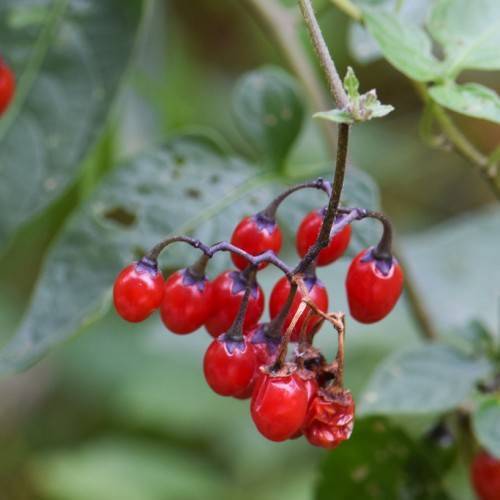
deadly nightshade
Solanum dulcamara
Also Known As - European bittersweetCycle:
Perennial
Watering:
Average
Hardiness Zone:
7
Flowers:
Flowers In Spring
Sun:
Deep shade, Filtered shade, Part sun/part shade
Soil:
Acidic, Humus rich
Cones:
Yes
Leaf:
Yes
Growth Rate:
Moderate
Maintenance:
Low
Drought Tolerant:
Yes
Care Level:
Medium
watering
Reeves skimmia plants should be watered frequently and thoroughly during the growing season (spring and summer) with water at room temperature. During this time, the soil should be kept constantly moist but not wet. As the plant enters dormancy in the fall and winter months, watering should be reduced to about once a month. During this time, it is important to ensure that the soil is mostly dry in-between waterings. A helpful tip is to stick your finger in the soil to approximately 2 inches in depth and if it feels dry to the touch, it is time to water.
sunlight
Reeves skimmia (Skimmia reevesiana) does best with bright indirect light most of the day. Depending on the season, they can tolerate full sun from morning to mid-afternoon, or from late morning to early evening. It is important to avoid intense full midday sun, as this can cause scorching of the leaves. In general, 4 to 6 hours of light each day is ideal. The plant should also be protected from strong winds that could damage the foliage.
pruning
Reeves skimmia should be pruned in late winter or early spring (March-April). Pruning should be light and careful. Remove any dead, diseased, or damaged branches with sharp, clean pruners. Remove unneeded or crossed branches to keep the plant well-shaped. Try to maintain the basic structure of the bush - don't over-prune. Also, Reeves skimmia needs minimal pruning. If the plant is too large or overgrown, you can lightly prune up to 1-third of the bush. But remember, skimmia is a slow-growing plant that flowers on old wood. If you prune it too hard, you may miss out on the fragrant white blooms.
